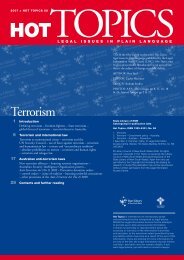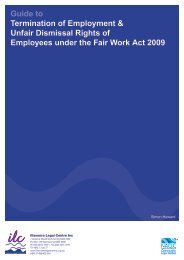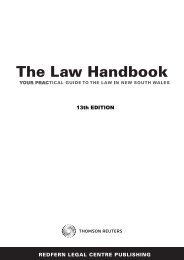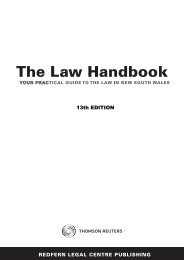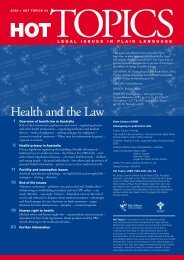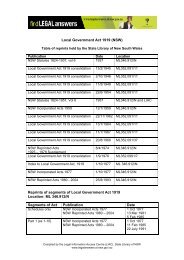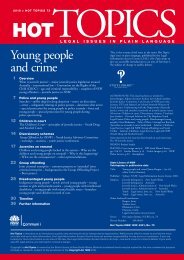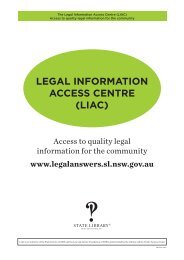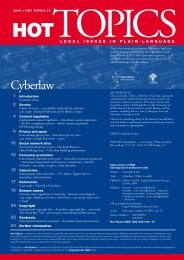Shelter - Hot Topics 57 - Legal Information Access Centre - NSW ...
Shelter - Hot Topics 57 - Legal Information Access Centre - NSW ...
Shelter - Hot Topics 57 - Legal Information Access Centre - NSW ...
- No tags were found...
You also want an ePaper? Increase the reach of your titles
YUMPU automatically turns print PDFs into web optimized ePapers that Google loves.
A common problem in share housing arises where oneco-tenant moves out of the premises, and the other cotenantsremain – often with a new housemate to replacethe departing co-tenant. In many cases, the departingco-tenant remains liable to the landlord under theresidential tenancy agreement, including for arrears anddamage incurred after they left. There are a number ofways to end the liability of the departing co-tenant. Oneis for the remaining housemates and the landlord to enterinto a new tenancy agreement. Otherwise, the departingco-tenant can assign their interest in the tenancy to theremaining co-tenants or the in-coming housemate, whoin turn indemnify the departing co-tenant against anyliability. Assignment must be done in a particular legalform (a ‘deed’). Each of these arrangements, however,requires the consent of all parties, including the landlord– without it, the departing co-tenant’s best option is toapply to the CTTT for an order terminating the tenancyon the ground of hardship (s 69A).THe cONSumer, Trader aNdTeNaNcy TribuNalThe CTTT was established by the Consumer, Trader andTenancy Tribunal Act 2001 (CTTT Act). The CTTThas eight divisions including Tenancy, ResidentialParks, Retirement Villages, and Strata and CommunitySchemes.The objects of the CTTT Act include ‘to enableproceedings to be determined in an informal, expeditiousand inexpensive manner’ (s 3(c)). The Tribunal is not acourt – its proceedings are similar, but less formal.For example, Tribunal members do not wear wigs andgowns, and are not addressed as ‘Your Honour’ they justuse their names, or ‘Chairperson’. Most parties appearingbefore the Tribunal represent themselves, and lawyersmay appear only in limited circumstances (althoughlandlords may be represented by their real estate agentand tenants may, with the Tribunal’s leave, be representedby an advocate). The Tribunal is not bound by the rulesof evidence: section 28(2). It does, however, make ordersthat are legally binding on parties.The Tribunal has a statutory obligation to conduct itsproceedings according to the rules of procedural fairness(s 28(2)). These rules are from the common law, and canbe summarised as follows:> the hearing rule: the Tribunal should give eachparty to a dispute an opportunity to state their casebefore it makes a determination, and should alloweach party to comment on any information adverse totheir case;> the bias rule: the Tribunal, in making adetermination, should not have a preconceivedopinion or a personal interest in the outcome of thedetermination;> the evidence rule: the Tribunal should makedeterminations only on the basis of reasonableevidence.The CTTT Act (section 68(2)) also provides that partiesmay request a rehearing if they may have suffered asubstantial injustice because, for example, new evidencehas arisen.Under section 67 of the CTTT Act, a party whobelieves that the Tribunal has made an error of law in adetermination may appeal to the Supreme Court.reNT cONTrOl aNd ‘prOTecTedTeNaNTS’Many people are aware of the term ‘rent control’ frompopular culture, especially American television shows.Many people are not aware that New South Wales hashad different forms of rent control legislation since beforethe Second World War, and a few tenancies remaincovered by rent control and related protections today.These tenancies are often called ‘protected tenancies.’The most important piece of rent control legislation isthe Landlord and Tenant (Amendment) Act 1948. Theprovisions of this Act reflect a desire by governmentsto control prices during the war and post-war periods,rather than principles of consumer protection. So, theAct provides significant protections against rent increasesand evictions. Rents can be limited to well below themarket rent, and the grounds for terminating tenanciesare very limited. On the other hand, the Act makes noprovision for tenants’ rights in relations to repairs andmaintenance.The Landlord and Tenant (Amendment) Act 1948 appliesto particular classes of premises (defined by the date ofconstruction, and whether certain types of leases wereever registered in relation to them). Amending legislationin the 1950s and 1960s curtailed the operation of theAct, and as new tenancies commenced many premiseswere removed from its application. No new protectedtenancies have been created since 1 January 1986(though existing protected tenancies may, in certainlimited circumstances, be inherited by a protectedtenant’s heirs: s 83A).Protected tenancies are often fraught relationships.When premises subject to the Landlord and Tenant(Amendment) Act 1948 are sold, the purchaser usuallyreceives a discount because of the restrictions of theAct: these landlords can make a windfall if the tenantmoves out. On the other hand, protected tenants arealmost always elderly and have spent many years intheir premises, and are greatly attached to their homes.Protected tenants must be vigilant against unscrupulouslandlords seeking to end their tenancies without a fairsettlement.10HOT TOPICS <strong>57</strong> > <strong>Shelter</strong>



